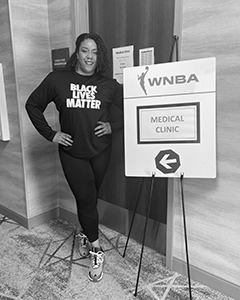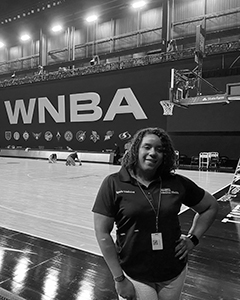In this issue, we talked to Dr. Melita Moore of MedStar National Rehabilitation Network in Washington, D.C. Dr. Moore works with the NBA G League Capitol City Go-Go, the WNBA Washington Mystics and NBA 2K Wizards District Gaming. She has been transitioning from a normal season to a satellite emergency room clinic to traditional office visits and telehealth and, finally, the WNBA "bubble" during COVID-19. The following article is based on her experience as of early October 2020.
 Melita Moore, MD, FAAPMR
Melita Moore, MD, FAAPMR
Attending Physician in PM&R
MedStar National Rehabilitation Hospital
Being in the bubble was weird. If anyone else explains their experience as something other than "odd" or "weird," they're not telling the truth. My primary role at MedStar Health is PM&R Sports Medicine, so I certainly did not expect to be in a quarantine environment, for sports to pause or shutdown entirely (in some cases), or even to be working on the frontlines.
My "pause moment" came the day before I was set to fly to Texas, preparing to enter a more cautious, but normal season. We knew COVID-19 was huge, but the magnitude hit me when, as I was packing my suitcase, the news broke on ESPN that the NBA shutdown due to the first cases of COVID-19 positive athletes in the league. Before this, I was still seeing patients in the office every day; I was ready to travel with our G League team (the development team for our NBA team), the Capitol City Go-Go, in what was already unprecedented protocol to follow NBA teams in season regardless of playoffs.
It was rough and something that I haven't fully had time to unpack because you just do it. If you try to process it during the moment, at least for me, there was going to be a breakdown somewhere. I know that for my hospital, our residents and our patients in D.C./Virginia/Maryland area, I had to put that aside and show up. You put yourself aside and you do what you need to do. That's the oath we took as physicians.
For me, that meant putting sports medicine to the side for a bit — though I still worked closely with our Esports team, the 2020 World Champion (!) Wizards District Gaming — and being redeployed to our satellite emergency room clinic. I'm a sports medicine doctor. I have not been in any ER setting, acute hospital setting since residency, but it was all-hands on-deck.
Initially, I believed my role in the satellite ER would be for anyone coming into the ER with musculoskeletal needs: car accident, back pain, fractures, musculoskeletal issues, etc. However, it really transitioned into something much more than that. I was now in scrubs, full PPE, in a satellite clinic taking care of anything that was coming through the door: non-acute chest pain, vaginal bleeding, a decubitus ulcer, etc. Because of the great consult system we had set up, we were able to work together to offset our first responders and our emergency room physicians in the normal ER so that they did not have to be impacted by so many people. This clinic lasted around eight weeks. On top of these 12-hour shifts, I still worked in my regular clinic.
From the satellite clinic, I transitioned back to our rehabilitation outpatient clinic inside of an inpatient hospital and my normal free-standing sports and spine building. The latter was almost right back to business as usual. The former was the opposite. Due to being in a hospital, there was more preparation when having a patient come into our office — I wore scrubs and worked largely with telehealth. At the sports and spine building, I had gone back to regular life, seeing patients in the office while wearing a mask and normal clothes.
While I worked on the frontlines, the NBA was weighing what to do with their leagues. In the end, the NBA finished their season, the G League did not. Because of the G League's outcome, we now faced the question of whether the WNBA would have the opportunity to play and, if so, how.
That's when, in late July, I entered the bubble. The bubble is a very different kind of place to be. I kept telling my family, "I'm going to the safest place in America. I'm getting tested every single day and being in a quarantine environment." Again, I'm a sports medicine doctor and a team physician. Being a team doctor is what gets me out of bed every day. To go from no sports to a place where there's sports 24/7, sign me up!
What I wasn't prepared for was the amount of work that I was going to have to do in the bubble. Our situation with the WNBA bubble was a lot different from the NBA bubble; we had vastly different resources and setup. The minimal resources that we did have were used in creative and imaginative ways and we were able to have a successful bubble, not only with zero COVID-19 cases, but also with success with keeping players healthy and on the court.
I was the one doctor — the only team physician — there on behalf of the WNBA to take care of all 12 teams, whereas the NBA had one doctor for every four teams. We also had a medical company that was there to provide "urgent care" type medicine for the 350+ people in the bubble. That team was comprised of a primary care sports medicine physician and her fellow, two nurses and a nurse practitioner. It was imperative, then, that we all work together.
With three games a day, it's physically impossible for one person to be at every single game, although that is what I was tasked to do. As with sports and medicine, it was a team effort; we all just pitched in and covered the games, evaluated and treated injuries on and off the court, coordinated appointments to specialists and imaging studies. In return, I helped to manage the medical clinic during the day with the rest of the team. My goal was to make sure those athletes were getting world class care — and we did just that. We were able to show that you don't need all of the "fancy-dancy" stuff to put on a successful bubble, although it would have been very nice to have. Hopefully, we were able to show other leagues and even collegiate conferences that may not have the large budgets such as the NBA, that they can still do a bubble and do it safely and make sure the athletes are well taken care of.
The bubble may have been strange, but it was exhilarating and exhausting. The days were grueling, between being in the arena and working directly with the athletes, but I would go back and do it all over again. I thrived in that environment and to have some level of normalcy during the pandemic provided me with a sense of comfort.
One of my biggest highlights for PM&R is that people need to see, to understand, to recognize that we are more than musculoskeletal physicians, we are primary care sports medicine physicians. We do anything and everything that needs to be done to take care of an athlete for all of their needs. I believe that more respect and recognition of the extent of care that we provide as sports medicine physicians is quite evident from having two physiatrists inside two professional sports bubbles that were going on. When we talk about sports medicine, a lot of people do not see physiatrists as being able to treat the "whole" athlete but we absolutely do. And so, it was important to have myself and my colleague, Dr. Bryan Murtaugh, not only be team physicians of professional teams, but representing physiatry inside of these sports bubbles. We are very fortunate that MedStar Health and MedStar National Rehabilitation Hospital understood the importance and gravity of having physiatrists represented in professional sports bubbles and allowed us time away from our patient responsibilities to participate in this historic sports season. This also shows residents and medical students who are pursuing PM&R the endless possibilities of being a physiatry-trained sports medicine physician.